AMD Zen 3 Ryzen Deep Dive Review: 5950X, 5900X, 5800X and 5600X Tested
by Dr. Ian Cutress on November 5, 2020 9:01 AM ESTSection by Andrei Frumusanu
CPU ST Performance: SPEC 2006, SPEC 2017
SPEC2017 and SPEC2006 is a series of standardized tests used to probe the overall performance between different systems, different architectures, different microarchitectures, and setups. The code has to be compiled, and then the results can be submitted to an online database for comparison. It covers a range of integer and floating point workloads, and can be very optimized for each CPU, so it is important to check how the benchmarks are being compiled and run.
We run the tests in a harness built through Windows Subsystem for Linux, developed by our own Andrei Frumusanu. WSL has some odd quirks, with one test not running due to a WSL fixed stack size, but for like-for-like testing is good enough. SPEC2006 is deprecated in favor of 2017, but remains an interesting comparison point in our data. Because our scores aren’t official submissions, as per SPEC guidelines we have to declare them as internal estimates from our part.
For compilers, we use LLVM both for C/C++ and Fortan tests, and for Fortran we’re using the Flang compiler. The rationale of using LLVM over GCC is better cross-platform comparisons to platforms that have only have LLVM support and future articles where we’ll investigate this aspect more. We’re not considering closed-sourced compilers such as MSVC or ICC.
clang version 10.0.0
clang version 7.0.1 (ssh://git@github.com/flang-compiler/flang-driver.git
24bd54da5c41af04838bbe7b68f830840d47fc03)
-Ofast -fomit-frame-pointer
-march=x86-64
-mtune=core-avx2
-mfma -mavx -mavx2
Our compiler flags are straightforward, with basic –Ofast and relevant ISA switches to allow for AVX2 instructions.
To note, the requirements for the SPEC licence state that any benchmark results from SPEC have to be labelled ‘estimated’ until they are verified on the SPEC website as a meaningful representation of the expected performance. This is most often done by the big companies and OEMs to showcase performance to customers, however is quite over the top for what we do as reviewers.
We start off with SPEC2006, a legacy benchmark by now, but which still has very well understood microarchitectural behaviour for us to analyse the new Zen3 design:
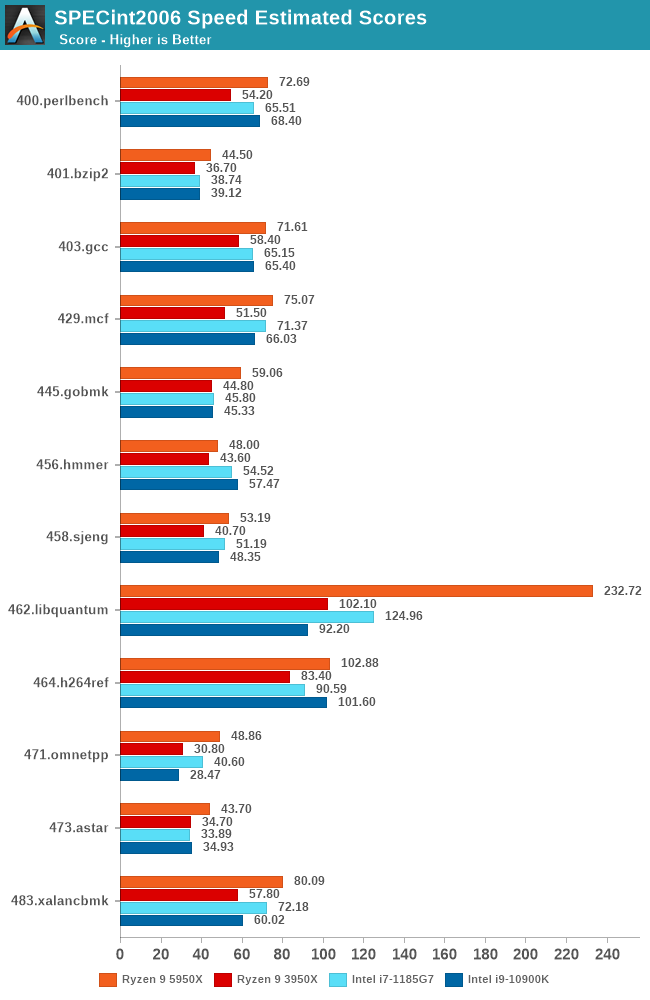
In SPECint2006, we’re seeing healthy performance upticks across the board for many of the tests. Particularly standing out is the new 462.libquantum behaviour of the Ryzen 9 5950X which is posting more than double the performance of its predecessor, likely thanks to the new much larger cache, but also the overall higher load/store throughput of the new core as well as the memory improvements of the microarchitecture.
We’re also seeing very large performance increases for 429.mcf and 471.omnetpp which are memory latency sensitive: Although the new design doesn’t actually change the structural latency to DRAM all that much, the new core’s much improved and smarter handling of memory through new cache-line replacement algorithms, new prefetchers, seem to have a large impact on these workloads.
400.perlbench is interesting as it’s not really a memory-heavy or L3 heavy workload, but instead has a lot of instruction pressure. I think that Zen3’s large boost here might be due to the new optimised OP-cache handling and optimisations as that would make the most sense out of all the changes in the new design – it’s one of the tests that has a very high L1I cache miss rate.
A simpler test that’s solely integer execution bound and sits almost solely in the L1D is 456.hmmer, and here we’re seeing only a minor uplift in performance only linear with the clock frequency increase of the new design, with only a 1% IPC uplift. Given that Zen3 doesn’t actually change its integer execution width in terms of ALUs or overall machine width, it makes sense to not see much improvements here.
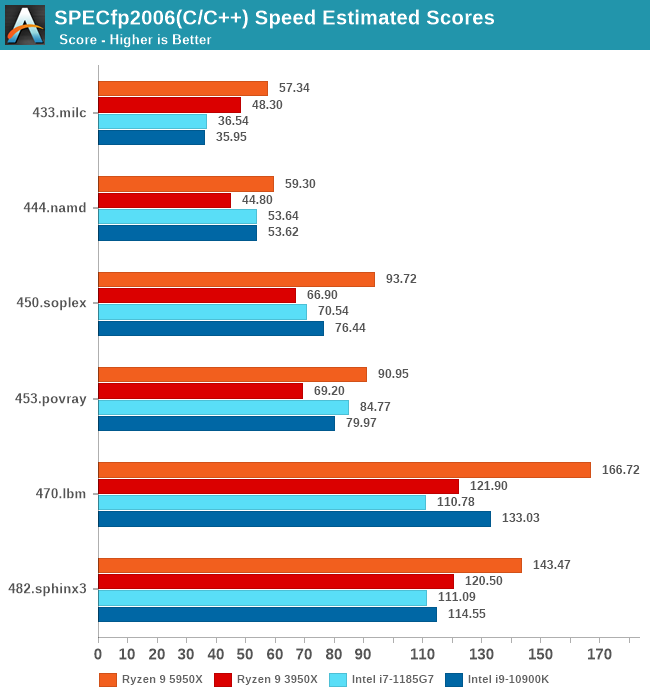
In SPECfp2006, we’re seeing more healthy boosts in performance across the board which is mostly due to the more memory intensive nature of the workloads, and we’re seeing large IPC uplifts in most tests due to the larger L3 as well as the better memory capabilities of the core. 433.milc sees a smaller uplift than the other benchmarks and that’s due to it being more DRAM memory bandwidth bound. 482.spinx is also seeing a smaller 9% IPC uplift due to it not being that memory intensive.
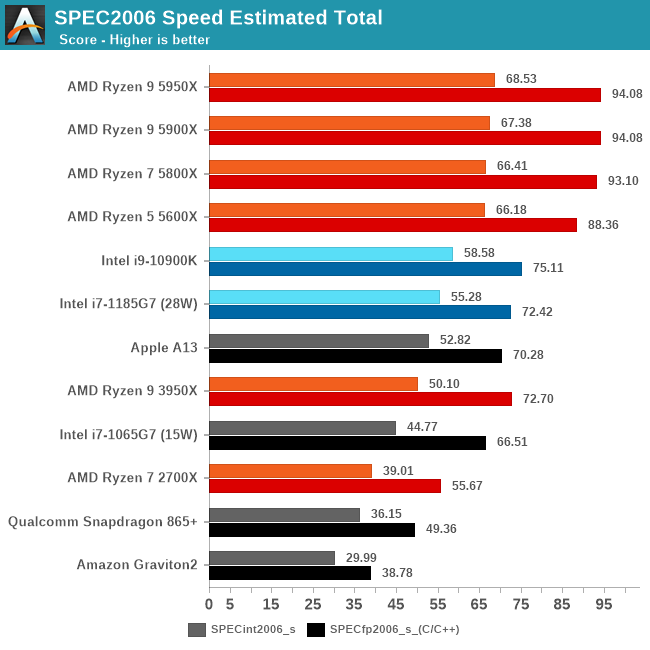
In the overall 2006 scores, the new Ryzen 5000 series parts are showcasing very large generational performance uplifts with margins well beyond that of the previous generation, as well as the nearest competition. Against the 3950X, the new 5950X is 36% faster in the integer workloads, and 29% faster in the floating-point workloads, which are both massive uplifts. AMD is also leaving Intel behind in terms of performance here with a 17% and 25% performance advantage against the 10900K.

In the performance per clock uplifts, measured at peak performance, we’re seeing a 20.87% median and 24.99% average improvement for the new Zen3 microarchitecture when compared to last year’s Zen2 design. AMD is still quite behind Apple’s A13 and A14 (review coming soon), but that’s natural given the almost double the microarchitectural width of Apple’s design, running at lower frequencies. It’ll be interesting to get Apple Silicon Mac devices tested and compared against the new AMD parts.
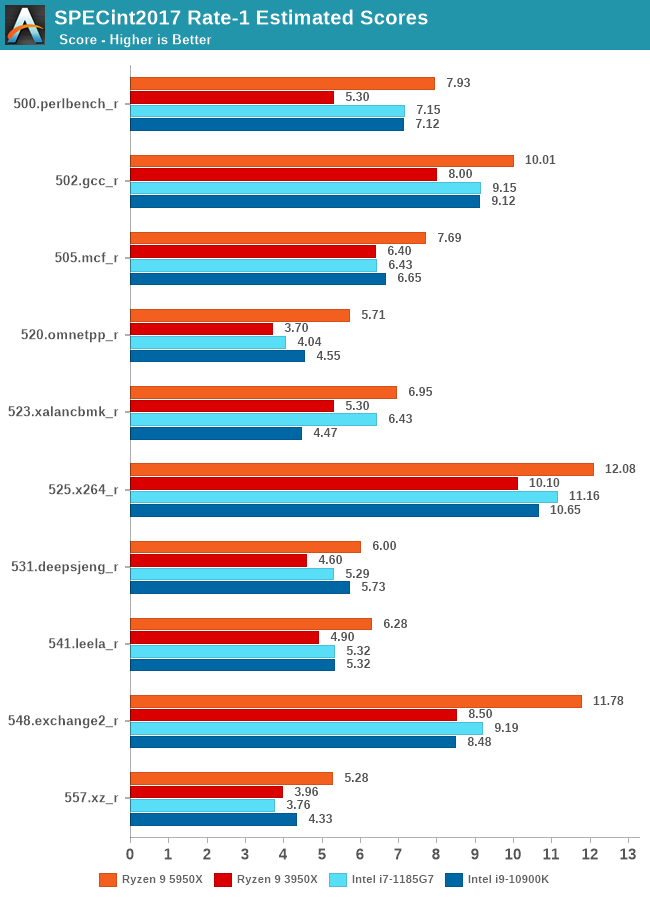
Moving onto the newer SPECint2017, we again see some large improvement of Zen3 depending on the various microarchitectural characteristics of the respective workloads. 500.perlbench_r again shows a massive 37% IPC uplift for the new architecture – again very likely to the new design and optimisations on the part of the OP-cache of the Zen3 design.
520.omnetpp again also shows a 42% IPC uplift thanks to the memory technologies employed in the new design. Execution throughput limited workloads such as 525.x264 are seeing smaller increases of 9.5% IPC due to again overall less changes on this aspect of the microarchitecture.
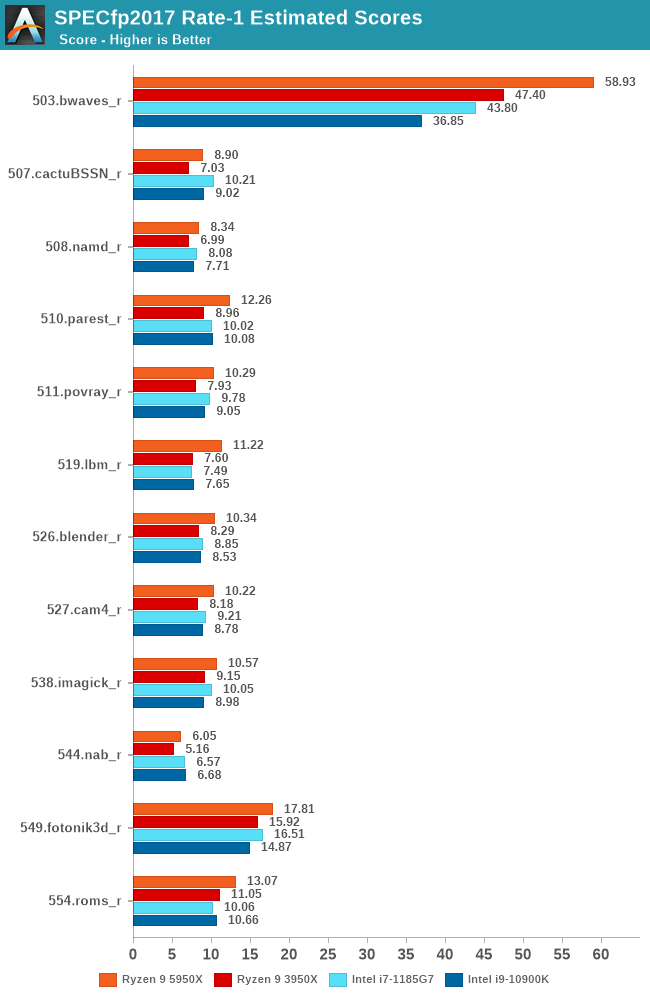
In SPECfp2017, we see a similar situation as previous workloads. Execution-bound workloads such as 508.namd or 538.imagick are seeing smaller IPC increases in the 9-6% range. Similarly, DRAM bandwidth starved workloads such as 549.fotonik3d and 554.roms are showcasing also smaller IPC boosts of 2.7 – 8.6%.
The more hybrid workloads which make good use of the caches are seeing larger performance improvements across the board. Up to a 35.6% IPC peak for 519.lbm.

In the SPEC2017 suite total performance figures, the new Ryzen 5000 also shine thanks to their frequency and IPC uplifts. Generationally, across the int2017 and fp2017 suites, we’re seeing a 32% and 25% performance boost over the 3950X, which are very impressive figures.
IPC wise, looking at a histogram of all SPEC workloads, we’re seeing a median of 18.86%, which is very near AMD’s proclaimed 19% figure, and an average of 21.38% - although if we discount libquantum that average does go down to 19.12%. AMD’s marketing numbers are thus pretty much validated as they’ve exactly hit their proclaimed figure with the new Zen3 microarchitecture.
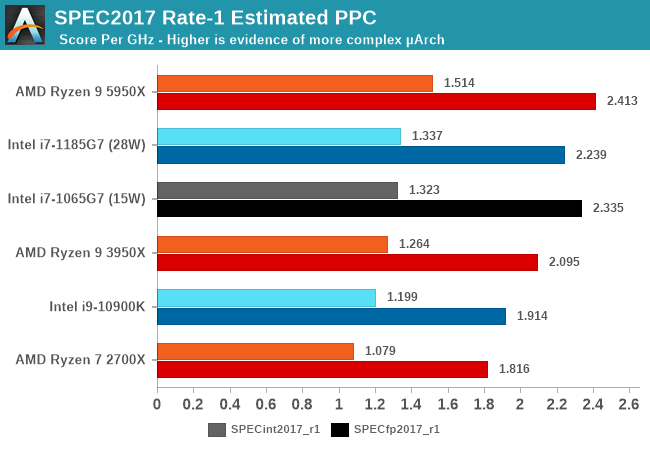
On the competitive landscape, this now makes Zen3 the undisputed leader in the x86 space, leaving Intel’s old Skylake designs far behind and also showing more design complexity than the newer Sunny Cove and Willow Cove cores.
Overall, the new Ryzen 5000 series and the Zen3 microarchitecture seem like absolute winners, and there’s no dispute about them taking the performance crown. AMD has achieved this through both an uplift in frequency, as well as a notable 19% uplift thanks to a smarter design.
What I hope to see from AMD in future designs is a more aggressive push towards a wider core design with even larger IPC jumps. In workloads that are more execution bound, Zen3 isn’t all that big of an uplift. The move from a 16MB to a 32MB L3 cache isn’t something that’ll repeated any time soon in terms of improvement magnitude, and it’s also very doubtful we’ll see significant frequency uplifts with coming generations. As Moore’s Law is slowing, going wider and smarter seems to be the only way forward for advancing performance.


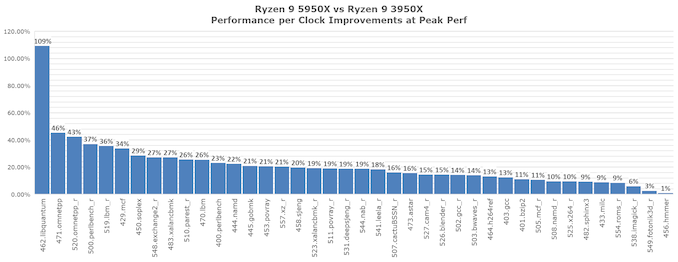








339 Comments
View All Comments
5j3rul3 - Thursday, November 5, 2020 - link
Rip Intel🤩🤩🤩Smell This - Thursday, November 5, 2020 - link
Chipzillah has got good stuff ... everyone is "just dandy" for the most part...
but, AMD has kicked Intel "night in the ruts" in ultimate price/performance with Zen3
Kangal - Saturday, November 7, 2020 - link
True, but the price hikes really hurt.For the Zen3 chips, it's only worth getting the:
- r9-5950X for the maximum best performance
- r5-3600X for the gaming performance (and decent value).
The 12 core r9-5900X is a complete no-buy. Whilst the r7-5800X is pretty dismal too, so both chips really need to be skipped. Neither of them have an Overclocking advantage. And there's just no gaming advantage to them over the 5600X. For more performance, get a 3950X or 5950X. And when it comes to productivity, you're better served with the Zen2 options. You can get the 3700 for much cheaper than the 5800X. Or for the same price you can get the 3900X instead.
Otherwise, if you're looking for the ultimate value, as in something better than the 5600X value... you can look at the 3600, 1600f, 3300X, 3100 chips. They're not great for gaming/single-core tasks, but they're competent and decent at productivity. Maybe even go into the Used market for some 2700X, 2700, 1800X, 1700X, 1700, 1600X, and 1600 chips as these should be SIGNIFICANTLY cheaper. Such aggressive pricing puts these options at better value for gaming (surprising), and better value for productivity (unsurprising).
DazzXP - Saturday, November 7, 2020 - link
Price hike doesn't really hurt that much, AMD was making very little money on their past Ryzen's because they had to contend with Intel Mindshare and throw more cores in as they did not quite have IPC and clock speeds, now they have all. It was as expected to be honest.Silma - Sunday, November 8, 2020 - link
Do you have any recommendations for motherboards for either a Zen3 or a Zen 2 (depending on availability of processors)? I want to spend as litte as possible on it, but it miust be compatible with 128 GB of RAM.AdrianBc - Sunday, November 8, 2020 - link
If you really intend to use 128 GB of RAM at some point in the future, you should use ECC RAM, because the risk of errors is proportional with the quantity of RAM.A good motherboard was ASUS Pro WS X570-ACE (which I use) previously at $300 but right now it is available at much higher prices ($370), for some weird reason.
If you want something cheap with 128 GB and ECC support, the best you can do is an ASRock micro-ATX board with the B550 chipset. There are several models and you should compare them. For example an ASRock B550M PRO4 is USD 90 at Amazon.
Silma - Wednesday, November 11, 2020 - link
Thanks for the input! Is ECC really necessary? The primary objective of the PC memory would be loading huge sound libraries in RAM for orchestral compositions. The PC would serve at the same time as gaming PC + Office PC.Spunjji - Sunday, November 8, 2020 - link
In the context of a whole system? Not really, no.In the context of an upgrade? Not at all, if you have a 4xx board you'll be good to go in January without having to buy a new board. That's something that hasn't been possible for Intel for a while, and won't be again until around March, when you'll be able to upgrade from a mediocre power hog of a chip to a more capable power hog of a chip.
Comparing new to used in terms of value of a *brand new architecture* doesn't really make much sense, but go for it by all means 👍 The fact remains that these have the performance to back up the cost, which you can see in the benchmarks.
leexgx - Sunday, November 8, 2020 - link
I would aim for the 5600x minimum unless your really trying to Save $100 as the 5600x is a good jump over the 3700x/3600xbiostud - Monday, November 9, 2020 - link
Uhm, no? For me the 5900X would make perfect sense. I game and work with/photo video editing, and would like to have my computer for a long time. The 5950X costs too much for my needs, the 5900X offers 50% more cores than the 5800X for $100 and the 5600X hasn't got enough cores when video editing. (Although I'm waiting for next socket before upgrading my 5820k)